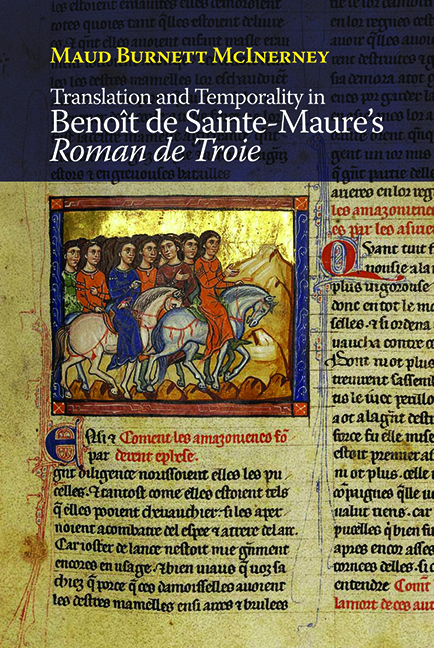Book contents
- Frontmatter
- Dedication
- Contents
- Acknowledgements
- List of Abbreviations
- Introduction: Trojan Time Machines
- 1 A Cupboard in Athens: Translating Troy
- 2 A Very Old Book, or How to Predict the Past
- 3 Ladies’ Time
- 4 Queer Time for Heroes
- 5 Hector in the Alabaster Chamber: Ekphrasis and its Discontents
- Conclusion: Trojan Futurities
- Appendix: The Manuscript Tradition of the Roman de Troie
- Bibliography
- Index
- Gallica
Introduction: Trojan Time Machines
Published online by Cambridge University Press: 07 October 2022
- Frontmatter
- Dedication
- Contents
- Acknowledgements
- List of Abbreviations
- Introduction: Trojan Time Machines
- 1 A Cupboard in Athens: Translating Troy
- 2 A Very Old Book, or How to Predict the Past
- 3 Ladies’ Time
- 4 Queer Time for Heroes
- 5 Hector in the Alabaster Chamber: Ekphrasis and its Discontents
- Conclusion: Trojan Futurities
- Appendix: The Manuscript Tradition of the Roman de Troie
- Bibliography
- Index
- Gallica
Summary
The primary subject of this book, its central time machine, is Benoît de St-Maure's Roman de Troie, which I will argue participates in the creation of a new kind of narrative time as the poem moves towards its inescapably tragic end. The Roman de Troie was one of the great medieval best-sellers. In its pages, Benoît invented the love story of Troilus and Briseida, which inspired, directly or indirectly, Boccaccio's Il Filostrato, Chaucer's Troilus and Criseyde, and Shakespeare's Troilus and Cressida. Indeed, the Roman de Troie generated the most familiar medieval version of the story of the Trojan War through its subsequent translation into Latin by Guido delle Colonne as the Historia destructionis Troiae, itself the source of Lydgate's Middle English Troy Book and of the Middle French text translated by Caxton into English as the Recuyell of the Historyes of Troye. Not until vernacular translations of the Aeneid, and eventually the Iliad itself, began to multiply in the early modern period would Benoît's version of the story lose its authority, but then it did so precipitously. From the seventeenth century onwards, it was little read. Although the text was edited by Leopold Constans between 1904 and 1912, only excerpts appeared in English, and the modern French facing page translation which appeared in 1998 was much abridged; the editors deemed its many battle scenes too much for modern sensibilities and cut most of them. There is something ironic about this version's dramatic reduction of Benoît's original, given the way he operated on his own source text, Dares of Phrygia's De Excidio Troiae, which he expanded almost beyond comprehension, turning a scant 52 pages of prose (in the Teubner version) into an octosyllabic poem over 30,000 lines long, twice as long as the Iliad.
This book explores the curious intersection of translation and temporality in the Roman de Troie and its sources and inspirations; it pays attention to the ways in which the act of translation from Late Latin into Old French, from Late Antiquity to the twelfth-century Renaissance, and from prose into verse also translates history into romance, reconfigures narrative time, and causes the appearance of unexpected textual objects, the time machines of the texts: characters, armour, clothing, and monuments.
- Type
- Chapter
- Information
- Publisher: Boydell & BrewerPrint publication year: 2021



